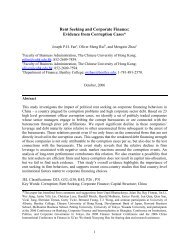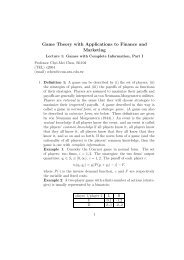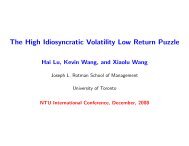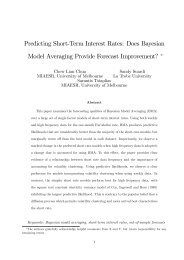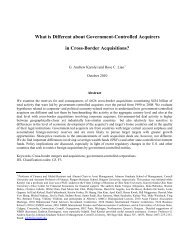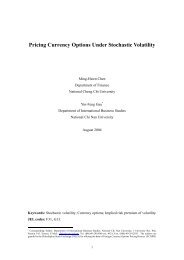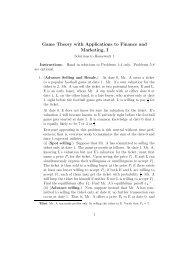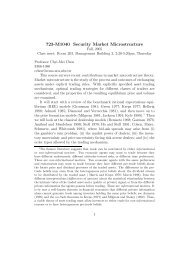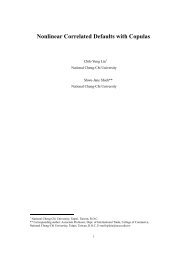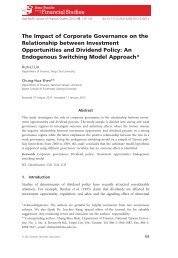723-M1040 Security Market Microstructure
723-M1040 Security Market Microstructure
723-M1040 Security Market Microstructure
Create successful ePaper yourself
Turn your PDF publications into a flip-book with our unique Google optimized e-Paper software.
<strong>723</strong>-<strong>M1040</strong> <strong>Security</strong> <strong>Market</strong> <strong>Microstructure</strong><br />
The Course Syllabus, Fall 2013<br />
6:30pm-9:20pm, Thursday, Room 204, Management Building 1<br />
Instructor: Chyi-Mei Chen<br />
(Tel) 3366-1086<br />
(Email) cchen@ccms.ntu.edu.tw<br />
This course surveys recent contributions in market microstructure theory.<br />
<strong>Market</strong> microstructure is the study of the process and outcomes of exchanging<br />
assets under explicit trading rules. With explicitly specified asset trading<br />
mechanisms, optimal trading strategies for different classes of traders are<br />
identified, and the properties of the resulting equilibrium price and volume<br />
are examined.<br />
It will start with a review of the benchmark rational expectations equilibrium<br />
(REE) models, where traders are price-takers endowed with differential<br />
information, who can submit a demand schedule at each and every trading<br />
date. Then we will review the theory of speculation and bubbles, and clarify<br />
and role of the no-trade theorem. We shall discuss the possible economic<br />
causes of market crash.<br />
The REE models assume that trades are consummated using the textbook<br />
Walrasian mechanism, where all traders are present at each and every<br />
trading date, and they can submit an infinite number of limit orders.<br />
The real-world trading mechanisms are mostly the combinations of a limit<br />
order market and a dealership market. In a limit order market, traders can<br />
submit either market or limit orders; a market order ensures certain execution<br />
at an uncertain price, and a limit order may result in non-execution,<br />
but when executed, it will be executed at the prespecified bid or ask price.<br />
In most cases, those who submit limit orders supply liquidity, and those who<br />
submit market orders demand liquidity. In a dynamic limit order market,<br />
un-executed limit orders are either cancelled or accumulated in a limit order<br />
book, and an un-executed limit order displayed in the book is subject to the<br />
1
isk of being “picked off” by better informed traders. The electronic trading<br />
systems such as BATS are limit order markets. Unlike the REE models,<br />
where traders are assumed to be non-strategic, it is assumed in models of<br />
limit order markets that traders are strategic.<br />
In a dealership market, there are designated dealers or market makers<br />
that supply liquidity to public traders. There may be a single dealer (e.g.<br />
the “specialist” in the NYSE in the last century) or multiple competing dealers<br />
(as in the NASDAQ) in the market. The models for a dealership market<br />
can be classified into two categories—the signaling models and the screening<br />
models. In the former the (probably better informed) public traders submit<br />
orders before the uninformed dealers announce bid and ask prices, and in<br />
the latter the uninformed dealers announce their quotes before taking orders<br />
from public investors. The former are order-driven models, and the latter<br />
are quote-driven models.<br />
After we go over the REE models, we shall first review the dealership<br />
models, and then the limit order models. Based on these discussions, we address<br />
issues regarding fragmentation and consolidation of securities markets.<br />
Consolidation of exchanges has become a prevalent phenomenon recently. We<br />
shall also discuss the role and impacts of algorithmic trading—an example is<br />
the high frequency trading.<br />
We shall then consider the theories of trading volume. The finance literature<br />
suggests that trade can be motivated by either informational or noninformational<br />
motives. Two economic agents may want to trade because they<br />
have different endowments, different attitudes toward risks, or different time<br />
preferences. These are non-informational motives. Two economic agents<br />
with the same preferences and endowments may want to trade because they<br />
have different pre-trade beliefs about the future price and dividend processes<br />
of the traded assets. The differences in the pre-trade beliefs may stem from<br />
the heterogeneous prior beliefs about the dividend stream to be distributed<br />
by the traded asset, from the different interpretations (differences of opinion)<br />
about the statistical relationship between the intrinsic value of the traded asset<br />
and a (public or private) signal, or from the different private information<br />
2
the agents possess before trading. These are informational motives. As will<br />
be shown in class, different trading motives tend to result in trades that exhibit<br />
different patterns in trading volume.<br />
We shall distribute lecture notes constantly, and refer to the following<br />
books regularly.<br />
• <strong>Market</strong> Liquidity: Theory, Evidence, and Policy, 2013, T. Foucault, M.<br />
Pagano, and A. Röell, New York: Oxford University Press.<br />
• <strong>Market</strong> <strong>Microstructure</strong>: Confronting Many Viewpoints, 2012, edited by<br />
F. Abergel et al., West Sussex, UK: The John Wiley & Sons.<br />
• Asset Pricing Under Asymmetric Information: Bubbles, Crashes, Technical<br />
Analysis, and Herding, 2001, M. Brunnermeier, New York: Oxford<br />
University Press.<br />
• <strong>Market</strong> <strong>Microstructure</strong> Theory, 1995, M. O’Hara, Cambridge, Masschusetts:<br />
Blackwell Publishers.<br />
Problem sets solving and the performances in the midterm exam and<br />
an oral presentation will jointly determine a student’s grade. A tentative<br />
schedule now follows.<br />
3
Week 1<br />
Week 2<br />
Week 3<br />
Week 4<br />
Week 5<br />
Week 6<br />
Week 7<br />
Week 8<br />
Week 9<br />
Week 10<br />
Week 11<br />
Week 12<br />
Week 13<br />
Week 14<br />
Week 15<br />
Week 16<br />
Week 17<br />
Rational Expectations Equilibrium (REE) Models<br />
REE Models (continued)<br />
Speculation, Bubbles, and No Trade Theorem<br />
Speculation and bubbles (continued)<br />
Order-driven Mechanisms<br />
Order-driven Mechanisms (continued)<br />
Quote-driven Mechanisms<br />
Limit Order <strong>Market</strong>s<br />
Fragmentation and Consolidation<br />
Algorithmic Trading<br />
Theory of Trading Volume<br />
Theory of Trading Volume (continued)<br />
Economic Causes for <strong>Market</strong> Crash<br />
Efficiency Issues of Insider Trading<br />
Oral Presentation<br />
Oral Presentation<br />
Oral Presentation<br />
4



